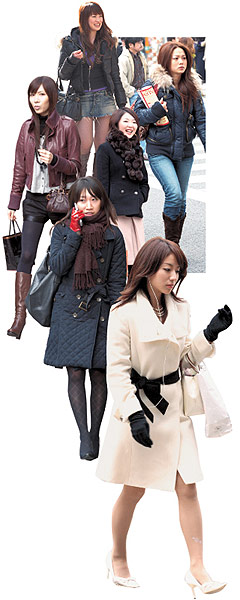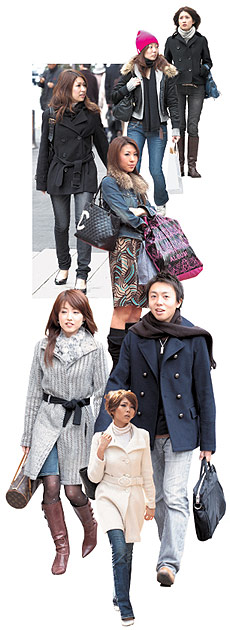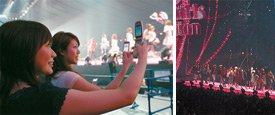Special Feature![]() The Cute World of Kawaii
The Cute World of Kawaii
Fashion-savvy consumers

Young women dressed the way they like. Fur trimmed apparel, down jackets, ribbon belted coats, leg-hugging blue jeans, and miniskirt/long boot ensembles are some of the fashions for the 2006/2007 fall and winter season. Pretty-girl style, chic-adult style...
The possibilities are numerous but the effect is the same — genuinely kawaii. Photos taken in Tokyo's Shibuya and Ginza districts (also see below right).
Japan's golden age of prosperity, which ended with the bursting of the speculative "bubble economy," encouraged women to indulge their dreams for classy Western brands and international fashions. At its peak in the 1980s, the bubble economy brought lots of young women into the workforce and gave them the cash to buy luxury brands. Almost a quarter century has passed since then, and many of those women became parents and gave their children fine clothes and an appreciation for superior products. So today's young adults naturally have a perceptive eye when it comes to fashion.
These discerning fashion lovers are quite particular about the care that goes into what they wear. At first sight, Apuweiser-riche brand items might appear simple, but look closer and you will find a surprisingly high level of craftsmanship. Skirt tucks on the plentiful side, cuffs bordering on the overly ample, skirt hems set off with lace. This attention to detail and style triggers a refreshing dose of surprise expressed as "kawaii! "
But according to Onishi, the CanCam editor-in-chief, the word "kawaii " is not exactly an expression — we should consider it more of an exclamation mark from deep inside the psyche of girls and young women.
Women's fashion in Japan continues to evolve, responding to the quest for kawaii. One can only wonder what the future holds for the world of cutie fashion. ![]()

Fashion Show Is No Ordinary Event
The Tokyo Girls' Collection
September 2006. The place: Yoyogi National Stadium in Tokyo. Ebihara Yuri, Oshikiri Moe and other star models appear one after the other from behind the scenes and stroll down the runway in the middle of the massive hall. The young women in the audience, the lucky ones able to get tickets, push excitement levels to fever pitch, mouthing each time in slow syllables: ka wa ii! "
Fashion shows usually exhibit a designer's collection to a limited number of invited buyers and media reps. Not this show. Called the Tokyo Girls' Collection, it turned the fashion show world on its head. The clothes were the latest fashions from apparel manufacturers, the models were fashion magazine stars, and the young women in the audience were not silent spectators but buyers eager for something for their own wardrobe. They busily used their cell phones to order what they saw on the runway.
The collection, the third exhibited this way, is reported to have sold about 23 million yen's worth of clothes in a single day. Little wonder fashion writers from France and other countries came and watched with mounting interest.
Xavel, Inc. was in charge of overall management of the show. Nagaya Ayako of the company feels that the key to future success in fashion sales is to leverage store sales with online shopping. Thanks to the Tokyo Girls' Collection, the company's sales via its cell phone-friendly website were phenomenal. Nagaya says, "Today, kawaii fashions offer the adult look and a more stylish flair, while moving in different directions. We intend to get everyone calling out in unison, 'Now that's kawaii! "

Left: Using cell phones to order clothes like the ones on the runway. When people in the audience murmur "kawaii! " the item they are looking at is almost bound to sell quickly. The fashion show/cellphone order combination is a revolutionary development.
Right: Models on the runway. The hall for the event was huge.